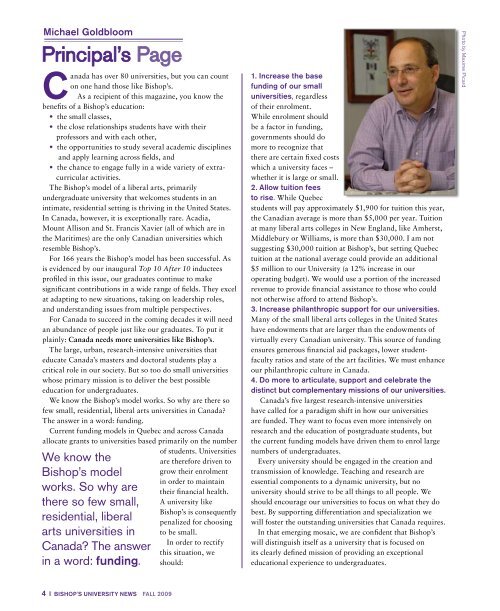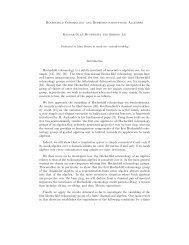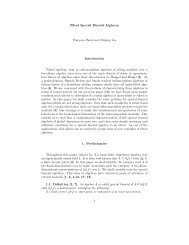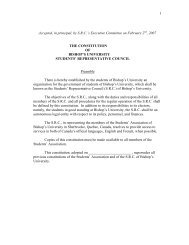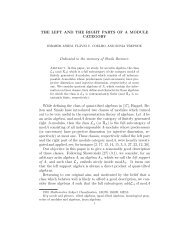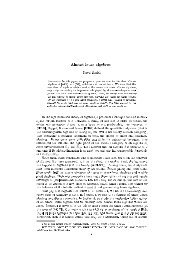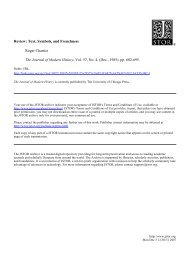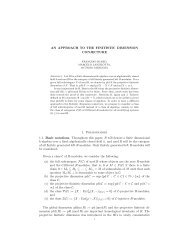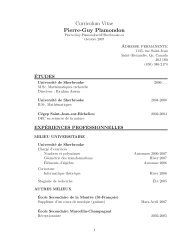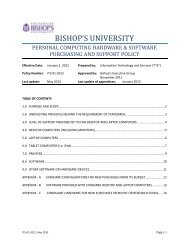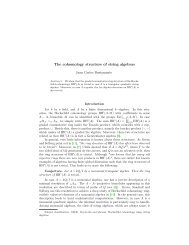Fall 2009 - Bishop's University
Fall 2009 - Bishop's University
Fall 2009 - Bishop's University
Create successful ePaper yourself
Turn your PDF publications into a flip-book with our unique Google optimized e-Paper software.
Michael Goldbloom<br />
Principal’s Page<br />
Canada has over 80 universities, but you can count<br />
on one hand those like Bishop’s.<br />
As a recipient of this magazine, you know the<br />
benefits of a Bishop’s education:<br />
• the small classes,<br />
• the close relationships students have with their<br />
professors and with each other,<br />
• the opportunities to study several academic disciplines<br />
and apply learning across fields, and<br />
• the chance to engage fully in a wide variety of extracurricular<br />
activities.<br />
The Bishop’s model of a liberal arts, primarily<br />
undergraduate university that welcomes students in an<br />
intimate, residential setting is thriving in the United States.<br />
In Canada, however, it is exceptionally rare. Acadia,<br />
Mount Allison and St. Francis Xavier (all of which are in<br />
the Maritimes) are the only Canadian universities which<br />
resemble Bishop’s.<br />
For 166 years the Bishop’s model has been successful. As<br />
is evidenced by our inaugural Top 10 After 10 inductees<br />
profiled in this issue, our graduates continue to make<br />
significant contributions in a wide range of fields. They excel<br />
at adapting to new situations, taking on leadership roles,<br />
and understanding issues from multiple perspectives.<br />
For Canada to succeed in the coming decades it will need<br />
an abundance of people just like our graduates. To put it<br />
plainly: Canada needs more universities like Bishop’s.<br />
The large, urban, research-intensive universities that<br />
educate Canada’s masters and doctoral students play a<br />
critical role in our society. But so too do small universities<br />
whose primary mission is to deliver the best possible<br />
education for undergraduates.<br />
We know the Bishop’s model works. So why are there so<br />
few small, residential, liberal arts universities in Canada?<br />
The answer in a word: funding.<br />
Current funding models in Quebec and across Canada<br />
allocate grants to universities based primarily on the number<br />
We know the<br />
Bishop’s model<br />
works. So why are<br />
there so few small,<br />
residential, liberal<br />
arts universities in<br />
Canada? The answer<br />
in a word: funding.<br />
of students. Universities<br />
are therefore driven to<br />
grow their enrolment<br />
in order to maintain<br />
their financial health.<br />
A university like<br />
Bishop’s is consequently<br />
penalized for choosing<br />
to be small.<br />
In order to rectify<br />
this situation, we<br />
should:<br />
1. Increase the base<br />
funding of our small<br />
universities, regardless<br />
of their enrolment.<br />
While enrolment should<br />
be a factor in funding,<br />
governments should do<br />
more to recognize that<br />
there are certain fixed costs<br />
which a university faces –<br />
whether it is large or small.<br />
2. Allow tuition fees<br />
to rise. While Quebec<br />
students will pay approximately $1,900 for tuition this year,<br />
the Canadian average is more than $5,000 per year. Tuition<br />
at many liberal arts colleges in New England, like Amherst,<br />
Middlebury or Williams, is more than $30,000. I am not<br />
suggesting $30,000 tuition at Bishop’s, but setting Quebec<br />
tuition at the national average could provide an additional<br />
$5 million to our <strong>University</strong> (a 12% increase in our<br />
operating budget). We would use a portion of the increased<br />
revenue to provide financial assistance to those who could<br />
not otherwise afford to attend Bishop’s.<br />
3. Increase philanthropic support for our universities.<br />
Many of the small liberal arts colleges in the United States<br />
have endowments that are larger than the endowments of<br />
virtually every Canadian university. This source of funding<br />
ensures generous financial aid packages, lower studentfaculty<br />
ratios and state of the art facilities. We must enhance<br />
our philanthropic culture in Canada.<br />
4. Do more to articulate, support and celebrate the<br />
distinct but complementary missions of our universities.<br />
Canada’s five largest research-intensive universities<br />
have called for a paradigm shift in how our universities<br />
are funded. They want to focus even more intensively on<br />
research and the education of postgraduate students, but<br />
the current funding models have driven them to enrol large<br />
numbers of undergraduates.<br />
Every university should be engaged in the creation and<br />
transmission of knowledge. Teaching and research are<br />
essential components to a dynamic university, but no<br />
university should strive to be all things to all people. We<br />
should encourage our universities to focus on what they do<br />
best. By supporting differentiation and specialization we<br />
will foster the outstanding universities that Canada requires.<br />
In that emerging mosaic, we are confident that Bishop’s<br />
will distinguish itself as a university that is focused on<br />
its clearly defined mission of providing an exceptional<br />
educational experience to undergraduates.<br />
Photo by Maxime Picard<br />
4 BISHOP'S UNIVERSITY NEWS FALL <strong>2009</strong>


